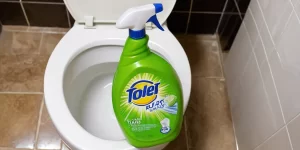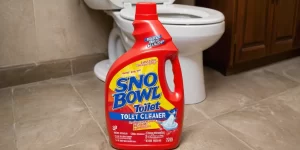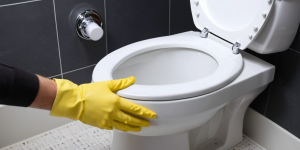When it comes to keeping your toilet sparkling clean, many homeowners are turning to innovative solutions like the in-tank cleaner. These ingenious devices not only promise a continuous cleaning experience but also add convenience to your bathroom routine. However, like any product, they come with their own set of advantages and disadvantages. In this comprehensive guide, we’ll dive into how in-tank cleaners work, explore their benefits and drawbacks, and compare them to other cleaning methods. By the end, you’ll be well-equipped to decide if an in-tank cleaner is the right choice for your home, along with tips for installation, maintenance, and environmental considerations. Get ready to transform your toilet cleaning experience!
Understanding In-Tank Toilet Cleaners
In-tank toilet cleaners are specialized cleaning agents that reside within the toilet tank and release cleaning solutions with each flush. They are designed to keep the toilet bowl clean and reduce the need for manual scrubbing. Understanding the mechanics and benefits of these cleaning products can greatly improve toilet hygiene and maintenance.
Key Features of In-Tank Toilet Cleaners
| Feature | Description |
|---|---|
| Continuous Release | Gradually dispenses cleaning agents every time the toilet is flushed, providing ongoing cleanliness. |
| Variety of Options | Available in different forms: tablets, gels, and cartridges, allowing users to choose based on preferences. |
| Bleach-Free Option | Some formulations are free from harsh chemicals, making them safer for families and plumbing. |
| Stain Prevention | Helps prevent mineral build-up and stains that can occur over time, keeping the toilet looking fresh. |
In-tank cleaners typically utilize surfactants and other cleaning agents that target common toilet issues like hard water stains, mineral deposits, and bacteria. By simply dropping a cleaner into the tank, you can ensure each flush contributes to the sanitation and freshness of your toilet bowl.
However, it’s essential to consider factors like the type of plumbing system and any sensitivities to certain chemicals before choosing an in-tank cleaner. These products can enhance your cleaning routine significantly, but understanding their operation is crucial for making an informed decision.
How In-Tank Cleaners Work
In-tank toilet cleaners are ingenious devices designed to simplify toilet maintenance and keep your bathroom fresh. These products generally consist of a small, chemical-filled capsule or dispenser that attaches to the toilet’s tank. Understanding how they function helps you appreciate their effectiveness.
Mechanism of Action
- Automatic Dispensing:
- Each time you flush, water fills the tank and dissolves a small amount of cleaner. This method ensures a consistent release of cleaning agents with every use.
- Continuous Cleaning:
- The cleaners typically contain disinfectants and detergents that continuously work to prevent the build-up of stains, mineral deposits, and bacteria. This long-term action keeps toilets cleaner between deep cleans.
- Variety of Options:
- Many in-tank cleaners come in various forms such as tablets, liquids, or gels. Each type utilizes similar principles but may vary in ingredients and effectiveness, as outlined in the following table:
| Type | Description | Pros | Cons |
|---|---|---|---|
| Tablets | Solid form that slowly dissolves | Long-lasting, easy to use | May not dissolve evenly |
| Liquids | Liquid cleaner that flows into the tank | Quick onset effect | Requires more frequent refill |
| Gels | Thicker consistency that clings to tank walls | Effective at cleaning edges | Can leave residue |
In summary, in-tank cleaners utilize a simple yet effective mechanism to promote continual cleanliness. Their ability to release cleaning agents automatically with every flush not only simplifies toilet care but also enhances hygiene in your bathroom space. By choosing the right type, you can enjoy the benefits of these products effectively.
Advantages of Using In-Tank Cleaners
In-tank toilet cleaners offer a variety of benefits that make them an appealing choice for homeowners seeking a more efficient cleaning solution. Here are some notable advantages:
Continuous Cleaning
One of the primary advantages of in-tank cleaners is that they provide continuous cleaning with every flush. This guarantees that your toilet remains fresh and hygienic without the need for daily scrubbing.
Easy to Use
In-tank cleaners are simple to install and operate. Most products come with easy-to-follow instructions, allowing anyone to set up their cleaning system without the need for professional help.
Cost-Effective
In the long run, in-tank cleaners can be a cost-effective solution. By reducing the frequency of deep cleaning sessions and preventing the buildup of hard water stains and limescale, these cleaners can conserve water and reduce the need for harsh chemical cleaners.
Variety of Options
In-tank cleaners are available in various formulations, allowing users to choose a product that best suits their needs. Here is a comparison table of common in-tank cleaner types:
| Type | Active Ingredient | Duration | Notes |
|---|---|---|---|
| Bleach-Based | Sodium Hypochlorite | Lasts up to 3 months | Powerful stain removal; can discolor some toilet components. |
| Blue Dye Cleaners | Quaternary Ammonium Compounds | Lasts up to 6 months | Provides a blue tint; not suitable for septic systems. |
| Enzymatic Cleaners | Enzymes | Varies (up to 3 months) | Environmentally friendly; effective against organic stains. |
Reduced Odor
Many in-tank cleaners contain deodorizing agents that help control unpleasant odors. This contributes to a fresher bathroom atmosphere, enhancing overall hygiene.
Less Labor-Intensive
With in-tank cleaners, the need for scrubbing and manual effort diminishes significantly. This allows you to spend less time cleaning and more time enjoying your space.
Overall, in-tank toilet cleaners provide an efficient, user-friendly solution, making them a favorable option for many households.
Disadvantages of In-Tank Cleaners
While in-tank cleaning solutions offer convenience, there are several drawbacks to consider before incorporating them into your toilet maintenance routine. Below are key points highlighting the disadvantages you may encounter with these products:
| Disadvantage | Description |
|---|---|
| Chemical Build-Up | Continuous exposure to cleaning agents can lead to a build-up of residue within the tank over time. This accumulation can eventually affect the flusher mechanism. |
| Potential Damage to Components | Strong chemicals might damage vital parts within the toilet tank, such as seals and flappers, leading to leaks or malfunctions that could require costly repairs. |
| Water Quality Concerns | Some in-tank cleaners may release harmful chemicals into the water supply, raising concerns about water safety and potential health implications for households. |
| Ineffective Cleaning | While these cleaners maintain a certain level of cleanliness, they may not effectively tackle tougher stains or hard water deposits without supplementary cleaning efforts. |
| Initial Cost | The upfront cost of purchasing in-tank systems may be higher compared to traditional cleaning methods like toilet bowl cleaners, discouraging some users from making the switch. |
Keeping these disadvantages in mind can help you weigh your options effectively. It’s crucial to evaluate how these issues might impact your toilet’s performance and your overall home maintenance approach.
Comparing In-Tank Cleaners to Other Cleaning Methods
When considering toilet cleaning solutions, it’s essential to evaluate how in-tank cleaners stack up against other methods. Below is a comparison of in-tank cleaners with traditional cleaning methods, offering insight into their effectiveness, convenience, and health impacts.
| Feature | In-Tank Cleaners | Traditional Cleaning Methods |
|---|---|---|
| Cleaning Frequency | Continuous cleaning with every flush | Dependent on user schedule |
| Ease of Use | Requires initial installation, maintenance-free | Manual scrubbing involved |
| Effectiveness | Consistent freshness and odor control | Can vary based on effort applied |
| Chemical Exposure | Less exposure during cleaning | Potential for harmful fumes |
| Cost Efficiency | Generally longer-lasting | Often requires more products over time |
Key Considerations
Cleaning Frequency:
In-tank cleaners provide continuous action, meaning your toilet is cleaned with every flush. Traditional methods require regular effort, making in-tank options convenient for busy households.
Ease of Use:
Once installed, in-tank cleaners work autonomously, offering a hassle-free experience. In contrast, traditional methods demand time and physical effort.
Effectiveness:
Both methods can be effective, but in-tank cleaners maintain a steady level of cleanliness, while traditional methods may yield inconsistent results based on individual diligence.
Chemical Exposure:
In-tank systems often contain milder chemicals, posing less risk during routine maintenance. Traditional methods often involve potent cleaners that can release strong odors.
Cost Efficiency:
While in-tank cleaners may require an upfront investment, they often prove to be more economical over time, as they can eliminate the need for multiple cleaning products.
By weighing these factors, you can make a more informed decision on the best cleaning method for your toilet.
Choosing the Right In-Tank Cleaner
Selecting the appropriate in-tank cleaner can significantly impact the cleanliness of your toilet while also ensuring the longevity of your plumbing systems. To make an informed choice, consider the following factors:
Ingredients Matter
When choosing an in-tank cleaner, pay close attention to the ingredients. Some cleaners contain harsh chemicals that can damage your toilet’s components or pipes over time. Opt for eco-friendly options with biodegradable ingredients.
| Ingredient Type | Benefits | Drawbacks |
|---|---|---|
| Natural Cleaners | Non-toxic, safe for plumbing | May require more frequent replacement |
| Chemical Cleaners | Potent cleaning power | Can be harmful to plumbing and the environment |
Formulation Types
In-tank cleaners come in various formulations, including tablets, gels, and liquids. Each type has unique advantages:
- Tablets: Easy to use and replace, providing consistent cleaning with minimal effort.
- Gels: Often stick to the toilet bowl, allowing for targeted cleaning but may need more frequent application.
- Liquids: Versatile for different cleaning tasks but can be less efficient in continuous cleaning.
| Type | Usage Frequency | Price Range |
|---|---|---|
| Tablets | Every 30 days | $3 – $10 |
| Gels | Every 15 days | $5 – $12 |
| Liquids | As needed | $4 – $15 |
Brand Reputation
Check customer reviews and ratings for various brands. Trustworthy brands often use quality ingredients and have a solid track record of effectiveness. Look for brands that align with your values, particularly regarding sustainability.
Scent Preferences
Lastly, consider the fragrance. An appealing scent can enhance your bathroom experience, but strong chemicals can be overpowering. Choose a product that leaves a pleasant, light fragrance without harsh odors.
By evaluating these factors thoughtfully, you will be equipped to select the right in-tank cleaner tailored to your needs, ensuring a fresh and hygienic toilet bowl daily.
Installation Process for In-Tank Cleaners
Installing an in-tank toilet cleaner is a straightforward process that can significantly simplify your bathroom cleaning routine. Below are the steps to effectively install an in-tank cleaner, ensuring that you maximize its cleaning benefits without unnecessary complications.
Step-by-Step Installation Guide
| Step | Description |
|---|---|
| 1. Gather Materials | Ensure you have the in-tank cleaner, gloves, and a sponge. |
| 2. Turn Off Water Supply | Locate the shut-off valve behind the toilet and turn it off to prevent flooding. |
| 3. Empty the Tank | Flush the toilet to empty the tank, allowing you to work with a dry surface. |
| 4. Remove the Tank Lid | Carefully lift the lid off the toilet tank and set it aside. |
| 5. Install the Cleaner | Follow the specific instructions on the product. Typically, this involves hanging or placing it in the designated area within the tank. |
| 6. Reinstate Tank Lid | Replace the lid securely on the tank once the cleaner is in place. |
| 7. Turn On Water Supply | Open the shut-off valve and let the tank fill back up. Ensure no leaks occur around the cleaner. |
| 8. Test the Cleaner | Flush the toilet to confirm that the cleaner is functioning correctly. |
Helpful Tips
- Safety First: Always wear gloves during installation to protect your hands from cleaning chemicals.
- Regular Checks: After installation, periodically check for leaks or issues to ensure the cleaner is working effectively.
- Follow Instructions: Each product may have specific installation requirements; refer to the manufacturer’s guidelines to avoid any mishaps.
Following these steps will promote effective use of in-tank cleaners, ensuring your toilet remains fresh and clean with minimal effort.
Maintenance Tips for In-Tank Cleaners
Maintaining in-tank cleaners is crucial for ensuring they function optimally and prolong their lifespan. Here are essential maintenance tips to keep your in-tank cleaning systems effective.
Regular Inspection
Inspect the in-tank cleaner regularly for any signs of wear and tear. Pay attention to:
| Component | What to Look For |
|---|---|
| Cleaner Tablets | Check for residue or complete dissolution. |
| Chamber | Look for cracks or blockages. |
| Water Level | Ensure adequate water for proper function. |
Refill and Replace
Most in-tank cleaners require periodic refilling or replacement of cleaning agents. Establish a schedule based on your usage frequency:
| Frequency | Action |
|---|---|
| Every Month | Replace or refill cleaning tablets. |
| Every Six Months | Assess the entire system for function. |
Clean the Tank
While the in-tank cleaner helps maintain cleanliness, periodic cleaning of the actual tank is also important. Consider the following steps:
- Turn Off Water Supply: Ensure no water enters the tank.
- Empty the Tank: Flush to remove remaining water.
- Scrub: Use a soft brush and a suitable cleaner to scrub the tank walls lightly.
Monitor Performance
Keep an eye on the toilet’s flushing effectiveness. If you notice slow drainage or lingering odors, it may indicate the need for maintenance or a replacement.
Replace if Ineffective
If the in-tank cleaner is not producing satisfactory results despite regular maintenance, it might be time to consider alternate cleaning solutions or explore a different product better suited for your needs.
By following these maintenance tips, you can ensure your in-tank cleaners remain efficient, making cleaning your toilet a breeze while extending the life of your system.
Environmental Impact of In-Tank Cleaners
When considering the use of in-tank toilet cleaners, it’s essential to evaluate their environmental impact. These products often contain chemicals that may not be eco-friendly, which raises concerns about their long-term effects on water quality and ecosystems. Below, we break down the key factors regarding their environmental footprint.
Chemical Composition
| Type of Cleaner | Common Chemicals | Eco-Friendliness |
|---|---|---|
| Standard In-Tank Cleaners | Chlorine, Phosphates | Potentially harmful |
| Eco-Friendly In-Tank Cleaners | Plant-based surfactants, Natural enzymes | More sustainable |
Standard in-tank cleaners typically include harsh chemicals like chlorine and phosphates. These substances can leach into the sewage system, impacting local water bodies and aquatic life. On the other hand, eco-friendly cleaners utilize natural ingredients, reducing their detrimental effects significantly.
Water Consumption
In-tank cleaners often promote continuous cleaning, leading to increased water usage. For instance, some products may require more frequent flushes, which contributes to higher water bills and strain on local water resources. Transitioning to more efficient in-tank solutions can help reduce this impact.
Packaging and Waste
The packaging of in-tank cleaners also plays a role in their environmental impact. Traditional plastic containers contribute to pollution and take centuries to decompose. Opting for brands that use biodegradable or recyclable materials can greatly mitigate this issue.
Conclusion
In summary, while in-tank toilet cleaners offer convenience, their environmental impact must be critically assessed. By choosing eco-friendly alternatives and considering their overall resource consumption, consumers can make informed decisions that promote sustainability without sacrificing cleanliness.
Frequently Asked Questions about In-Tank Cleaners
As more households opt for in-tank toilet cleaners, several questions arise regarding their effectiveness, safety, and maintenance. Below is a curated FAQ section addressing the most common inquiries.
| Question | Answer |
|---|---|
| How often should I replace the cleaner? | It’s recommended to replace in-tank cleaners every 3-6 months, depending on usage and product type. Regular checks can ensure optimal cleaning. |
| Are in-tank cleaners safe for plumbing? | Most in-tank cleaners are designed to be safe for plumbing systems, but it’s important to check the product label for any specific warnings. |
| Will in-tank cleaners stain my toilet? | While many in-tank cleaners are formulated to prevent staining, certain products may cause discoloration over time, especially if left too long. |
| Can in-tank cleaners damage toilet components? | Generally, reputable in-tank cleaners won’t damage internal components, but it’s prudent to avoid those with harsh chemicals that could corrode parts. |
| Are there eco-friendly options available? | Yes, many brands offer environmentally friendly in-tank cleaners that use natural ingredients to effectively clean without harmful side effects. |
| How do I know which in-tank cleaner to choose? | Consider factors like cleaning performance, fragrance, and environmental impact. Reviews and comparisons can help narrow down the best options for your needs. |
These FAQs provide clarity on using in-tank toilet cleaners and can assist potential buyers in making informed choices. Always perform due diligence and opt for products that align with your cleaning and environmental preferences.
Frequently Asked Questions
What is an in-tank toilet cleaner and how does it work?
An in-tank toilet cleaner is a product designed to be placed within the toilet tank to continuously release cleaning agents into the bowl with each flush. It typically contains disinfecting chemicals that help to prevent stains, eliminate odors, and maintain a fresh environment in the toilet bowl. As the toilet is flushed, water passing through the tank carries these cleaning agents into the bowl, providing ongoing cleaning benefits without the need for constant manual scrubbing.
What are the benefits of using an in-tank toilet cleaner?
The benefits of using an in-tank toilet cleaner include consistent cleaning, the elimination of hard water stains and odors, and reduced frequency of manual cleaning. This type of cleaner can save time and effort while ensuring that the toilet remains sanitary between deeper cleanings. Additionally, some formulations have antibacterial properties that can enhance the overall hygiene of your bathroom, making it a convenient option for maintaining toilet cleanliness over time.
Are there any drawbacks to using in-tank toilet cleaners?
Yes, there are a few drawbacks to consider when using in-tank toilet cleaners. Some products may cause discoloration of toilet components, especially if they contain harsh chemicals. Additionally, over time, these cleaners can lead to the deterioration of rubber parts within the toilet tank, such as seals and flappers, which might necessitate more frequent repairs or replacements. It’s essential to choose products specifically labeled as safe for use in toilet tanks to mitigate these risks.
How often should I replace my in-tank toilet cleaner?
Most in-tank toilet cleaners will last approximately 2 to 3 months, but this can vary depending on the brand and the water quality in your area. It’s essential to monitor the product’s effectiveness and replace it when you notice a decrease in cleaning performance or when the cleaner appears to have dissolved completely. Regularly checking the tank and bowl for stains or odors can help determine when it’s time for a replacement.
Are there eco-friendly options for in-tank toilet cleaners?
Yes, there are eco-friendly options for in-tank toilet cleaners available on the market. These products often use natural ingredients and biodegradable materials, making them safer for both the environment and human health. When choosing an eco-friendly cleaner, look for certifications or labels indicating that the product is free from harsh chemicals, dyes, and fragrances. Reading customer reviews and product descriptions can also provide insights into the effectiveness of these environmentally-conscious choices.





